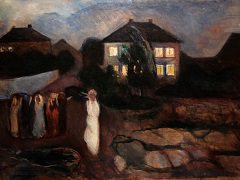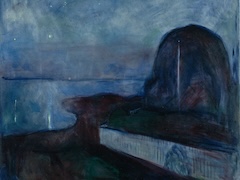Dance on the Shore, 1900-02 by Edvard Munch

As with Where do we come from? What are we? Where are we going? by Paul Gauguin, Munch's completion of the central image of the Frieze meant that greater ease and fluency could emerge in subsequent works as the pressure of expression lessened. This is shown by the new richness and delicacy in the handling of paint, the modulation of colour, and the harmonious intertwining of human and natural motifs in this work.
The calm of the moonlight shining on the gently incoming waves, echoes the bright whirling forms of the girls, white and yellow, circling at the joining point of land and sea, as though at ease with both. The cleft in the land echoes the band of moonlight, and the curving arch of the trees guides the eye down to the shore without obscuring the mysterious dark-clothed figures in the shadows on the right. These black figures are no more than small reminders of the tensions in the previous plate, reduced here to manageable proportions yet providing just the right amount of discordance in order to allay blandness. Munch used this theme in the frieze he designed for Max Reinhardt's 'Kammertheater' in 1906-7.




















